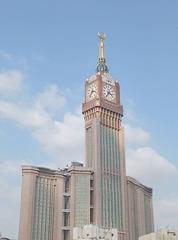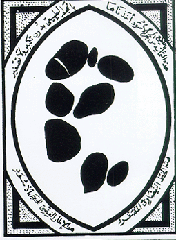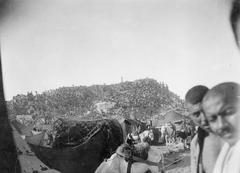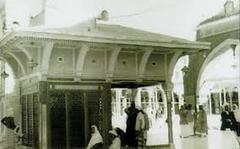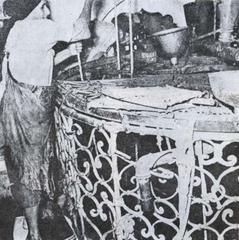Visiting Bay’Ah Mosque, Mecca: Comprehensive Guide to History, Visiting Hours, Tickets, and Tips
Date: 14/06/2025
Introduction
Bay’Ah Mosque, also known as Masjid al-Bay’ah or the Mosque of Aqaba Hill, stands as a profound testament to the early Islamic era. Located near Mina in Mecca, Saudi Arabia, it marks the site of the historic Second Pledge of Al-Aqaba in 621 CE—a decisive moment when the Ansar of Medina pledged allegiance to Prophet Muhammad (PBUH). This event paved the way for the Hijrah and the formation of the first Islamic community. Commissioned by Abbasid Caliph Abu Ja’far al-Mansur in 761 CE, the mosque is not only an architectural relic but also a living symbol of unity, justice, and faith.
This article is a comprehensive guide for pilgrims, history enthusiasts, and travelers interested in visiting Bay’Ah Mosque. Here, you’ll find detailed insights into its historical significance, architectural features, visitor information, tips for planning your visit, and its enduring place in Islamic heritage. For further planning, consult resources such as Welcome Saudi, Trek.zone, and Madain Project.
Table of Contents
- Historical Background
- Architectural Features and Preservation
- Visitor Information
- Cultural and Religious Significance
- Practical Guidance
- Frequently Asked Questions (FAQ)
- Summary and Call to Action
- References and Further Reading
Historical Background
The Second Pledge of Al-Aqaba: Cornerstone of Islamic Community
Bay’Ah Mosque was built at the exact location where, in 621 CE, approximately 73 men and women from Yathrib (Medina) pledged their allegiance to Prophet Muhammad (PBUH) (Welcome Saudi). This pledge, known as the Second Pledge of Al-Aqaba, was a solemn commitment to defend the Prophet and the nascent Muslim community at any cost. The significance of this event is immortalized in the Qur’an (Surah Al-Fath 48:18), where Allah expresses pleasure with those who gave their allegiance under the tree (iqna.ir).
This moment not only marked the beginning of Hijrah—the migration to Medina—but also the establishment of the first Islamic polity based on justice, equality, and brotherhood (Trek.zone).
Construction and Abbasid Legacy
The mosque was commissioned in 761 CE (144 AH) by Abbasid Caliph Abu Ja’far al-Mansur to commemorate this pivotal event. Inscriptions within the mosque confirm its Abbasid origins. Later, it underwent significant restoration under Caliph Al-Mustansir Bi’llah in 1227 CE and during the Ottoman era, ensuring its preservation for future generations (Madain Project; RCMC).
Architectural Features and Preservation
Minimalist Design: Reflecting Early Islamic Values
Bay’Ah Mosque’s architecture is understated yet purposeful, reflecting the simplicity and humility of early Islamic design (Lonely Planet). The mosque features an open courtyard (sahn), an arched entrance, and uncovered prayer spaces. The qibla wall faces southwest towards Mecca, and the original roof—once constructed from wood and palm trunks—has not survived.
Key elements include:
- Courtyard: Spacious, surrounded on three sides, facilitating gatherings and prayer.
- Mihrab and Niches: Central mihrab and flanking niches on the qibla wall.
- Arcades: Two interior arcades with a series of five arches each, supported by stone pillars.
- Minaret: A single, modest minaret serves as a historic call to prayer point.
Restoration and Preservation Efforts
Bay’Ah Mosque has been the focus of recent preservation projects, including those led by Saudi authorities. Restoration efforts maintain its original Abbasid character while ensuring structural stability, and the mosque remains open for prayer and reflection (scoopempire.com).
Visitor Information
Visiting Hours and Tickets
- Hours: Open daily, typically from dawn until dusk. Schedules may shift during Hajj and Ramadan.
- Entry: Free of charge; no ticket or reservation required (Welcome Saudi).
Accessibility and Travel Tips
- Location: Near Mina, about 300 meters from the Jamarat Bridge and approximately 5–7 kilometers east of Masjid al-Haram (Madain Project).
- Transport: Best reached by taxi or private car outside Hajj season, or via Hajj shuttle buses and group tours during pilgrimage (almatar.com).
- Accessibility: Ground-level entrance, but some uneven surfaces and steps inside may challenge those with mobility issues. Visitors with disabilities should plan accordingly.
On-Site Facilities
- Ablution Areas and Restrooms: Available but basic.
- Shops and Food: Limited on-site; small eateries and convenience stores operate nearby, especially during Hajj.
Cultural and Religious Significance
Pilgrimage Connections
While not a required stop during Hajj or Umrah, Bay’Ah Mosque is integral for pilgrims seeking to connect with the roots of Islamic community and leadership. Its location near the Jamarat Bridge and Mina makes it a convenient and meaningful addition to the pilgrimage route (Trek.zone).
Educational and Heritage Value
Bay’Ah Mosque serves as an educational landmark, illuminating the values of loyalty, sacrifice, and brotherhood that define Islamic history. Its modest size and open design invite reflection and learning, often enhanced by group tours or guides (iqna.ir).
Practical Guidance
Dress Code and Etiquette
- Dress: Modest Islamic attire is mandatory. Men should wear long trousers and sleeved shirts; women must wear an abaya and cover their hair.
- Shoes: Remove before entering the prayer area.
- Behavior: Maintain silence and respect; avoid photography inside during prayers.
Safety and Accessibility
- Security: Strict, especially during Hajj. Carry ID and permits.
- Health: Stay hydrated, use sun protection, and follow any health advisories (airlinkhajjandumrah.com).
- Facilities for Disabled: Limited; bring assistance if needed.
Combining Bay’Ah Mosque with Other Sites
- Jamarat Bridge: Site of the Stoning of the Devil ritual.
- Masjid al-Khaif: Another historic mosque in Mina.
- Mount Arafat: Key Hajj site, a short drive away.
Frequently Asked Questions (FAQ)
Q: What are the visiting hours for Bay’Ah Mosque?
A: Open daily from dawn to dusk; hours may shift during Hajj and Ramadan.
Q: Is there an entry fee?
A: No, entry is free.
Q: Who can visit Bay’Ah Mosque?
A: Only Muslims can visit Mecca and its religious sites, including Bay’Ah Mosque.
Q: Are guided tours available?
A: Not regularly on-site, but many Hajj and Umrah operators include it in their tours.
Q: Is the mosque accessible for people with disabilities?
A: Accessibility is limited due to historic structure; assistance is recommended.
Q: Is photography allowed?
A: Permitted outside; discouraged inside, especially during prayers.
Summary and Call to Action
Bay’Ah Mosque is a cornerstone of Islamic heritage, symbolizing the unity and faith of the early Muslim community through the Second Pledge of Al-Aqaba. Its Abbasid-era architecture and historical resonance make it a must-visit site for pilgrims and history enthusiasts. Visitors are encouraged to plan their trip outside peak Hajj periods, adhere to modest dress codes, and approach the site with respect.
For a richer experience, consider using the Audiala app for guided tours, up-to-date visitor information, and tips tailored for your spiritual journey. Follow Audiala for the latest updates, insights, and community engagement.
Explore related Mecca pilgrimage resources:
References and Further Reading
- Welcome Saudi: Bay’Ah Mosque Mecca - Visiting Hours, Tickets & Historical Significance
- Trek.zone: Bay’ah Mosque Visiting Hours & Historical Significance in Mecca
- Madain Project: Masjid al-Bay’ah - History and Significance
- Almatar: Bay’Ah Mosque Visiting Hours and Practical Guide for Pilgrims in Mecca
- iqna.ir: Historic Mosques in Mecca Remain Overlooked Amid Urban Growth, Expert
- scoopempire.com: Bringing Back Life to the Past – 5 Mosques in Saudi Arabia Being Restored
- airlinkhajjandumrah.com: Mekka & Umrah 2025
- Hikersbay: Best Time to Visit Mecca
